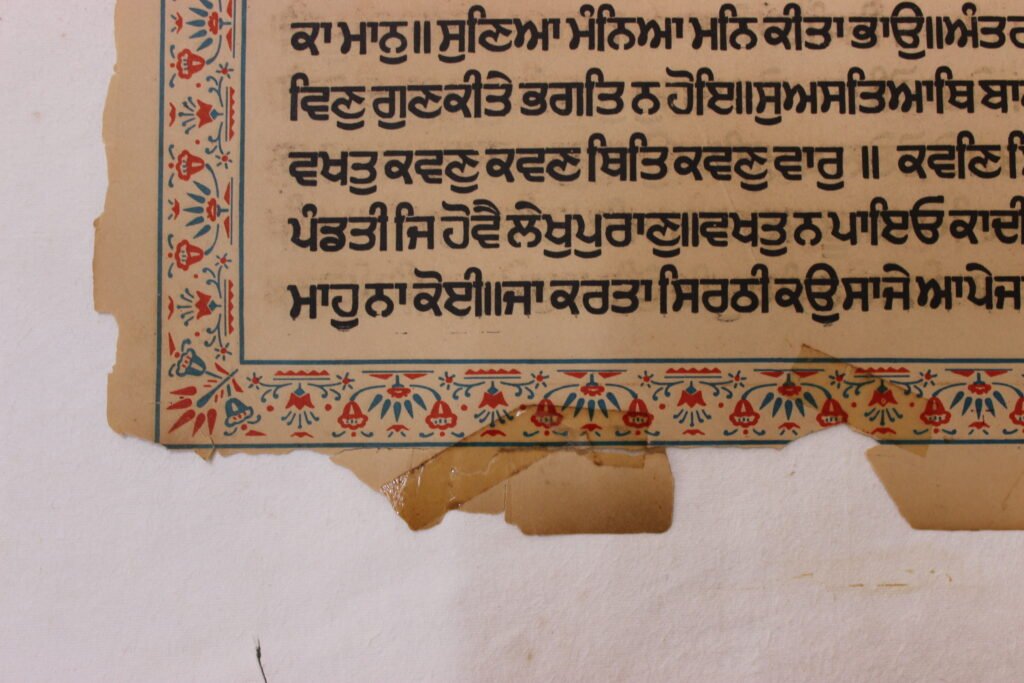By Surjit Singh, Art Conservator | ConservEdu Enterprises
In the sacred world of Sikh heritage, manuscripts and historical documents are not just ink on paper—they are living testimonies of a spiritual legacy that transcends time. However, preserving this legacy demands a deep sense of responsibility and a scientific approach. Unfortunately, in many cases, shortcuts like the use of cellotape (pressure-sensitive adhesive tapes) have done irreversible damage to these precious objects. At ConservEdu Enterprises, we raise our voice firmly: No to Cellotapes!
The Hidden Enemy: Why Cellotape is Harmful
Cellotape, commonly found in homes and offices, is often misused in libraries, gurdwaras, and private collections to repair tears or reattach loose pages in historical texts. Its ease of use makes it tempting. But behind its temporary fix lies a chemical time bomb. The adhesive in cellotape oxidizes over time, leaving behind yellow stains, embrittled surfaces, and permanent disfigurement. Instead of holding history together, cellotape speeds up its disintegration.
This becomes even more tragic when it affects Sikh manuscripts—Pothis, Janamsakhis, Hukamnamas, and handwritten Gutkas—many of which are hundreds of years old. These are not just religious texts but also primary historical sources that represent the Sikh way of life, philosophy, language, and regional material traditions like Gurmukhi calligraphy, natural inks, and traditional binding structures.
The Need for Conservation-Grade Materials
Conservation science offers much safer and reversible alternatives for repairing and preserving paper. These include:
-
- Japanese tissue paper (acid-free and long-fibered)
-
- Wheat starch paste (reversible and non-acidic)
-
- Methyl cellulose and Klucel-G adhesives
-
- Acid-free archival boards and boxes
-
- Humidity chambers and flattening under controlled conditions
These materials are developed with decades of research and global museum standards in mind. They ensure minimal intervention, maximum reversibility, and most importantly, respect for the original material.
At ConservEdu Enterprises, led by Surjit Singh Conservator, we consistently apply these international standards while grounding them in the Indian and Sikh context. For instance, while European endbands are commonly known, we also focus on preserving Gurmukhi endband structures, traditional to Sikh manuscripts. These delicate details often get ignored or damaged when handled by untrained hands or fixed with synthetic materials like cellotape or commercial glues.
Bridging Heritage and Science
One of the guiding principles of our work is that every manuscript deserves a unique conservation plan, based on its age, material, historical context, and current condition. We undertake non-invasive condition assessments, scientific ink composition analysis, and pH level testing before beginning any restoration work.
We have presented our scientific studies and methodologies at several global platforms, including:
-
- Copenhagen University, Denmark – on Composition Analysis of Gurmukhi Inks
-
- Rare Books Preservation Conference in Moscow, Russia – where we taught European conservators about traditional Gurmukhi endbands
-
- Collaborations with conservation labs and libraries in India, Europe, and Canada
Empowering Gurdwaras and Caretakers
One of our missions is to educate the caretakers of Sikh heritage—whether individuals, gurdwara committees, or academic libraries—about the dangers of improper repair and storage. We offer training, workshops, and printed guidelines on:
-
- Safe handling of old Pothis
-
- Storage in acid-free boxes or wrapped in unbleached cotton cloth
-
- Avoidance of plastic covers, cello-wraps, and tape
-
- Use of digital documentation for access instead of direct handling
We strongly encourage the Sikh community to avoid makeshift repairs using everyday materials like cellotape, synthetic glue, thermocol, or lamination films. These may offer a quick fix but cause permanent loss in the long run.
Preserving Spiritual and Material Legacy
As a Sikh and as a conservator, I believe our relationship with Sikh heritage is not just visual or historical—it is spiritual. Every ink stroke in a historic Pothi, every handmade folio, and every faded illustration carries the vibration of the times it was created in. If we truly value this inheritance, we must invest in proper conservation.
This is not a call only for scholars or collectors. This is a call for every Sikh and heritage lover to rise in collective responsibility.
At ConservEdu Enterprises, our mission is to combine scientific knowledge, spiritual reverence, and professional training to safeguard this irreplaceable legacy for future generations. With years of hands-on experience and guidance from saints and scholars, we carry forward this seva with love, humility, and precision.
Let us say it together: No to Cellotapes! Yes to Scientific Conservation!
Keywords: Sikh Heritage Conservation, Surjit Singh Conservator, No to Cellotapes, Scientific Manuscript Conservation, Gurmukhi Ink, Pothi Repair, ConservEdu Enterprises, Paper Conservation India, Endband Structure, Traditional Bookbinding Sikh
